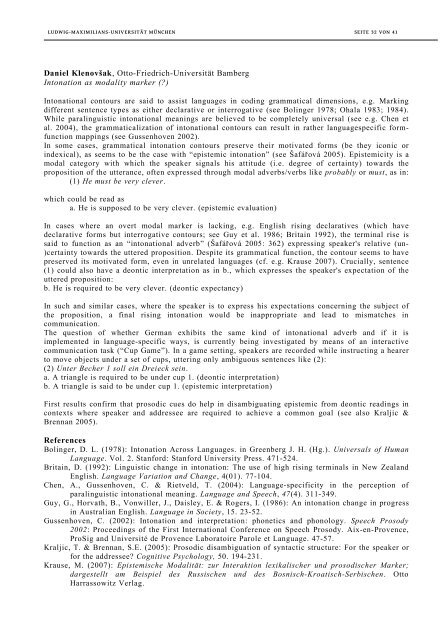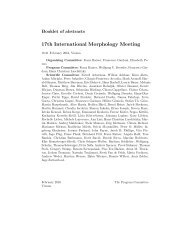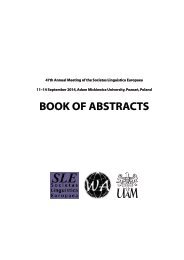Tagungsheft_STaPs_6
Tagungsheft_STaPs_6
Tagungsheft_STaPs_6
Erfolgreiche ePaper selbst erstellen
Machen Sie aus Ihren PDF Publikationen ein blätterbares Flipbook mit unserer einzigartigen Google optimierten e-Paper Software.
LUDWIG-MAXIMILIANS-UNIVERSITÄT MÜNCHEN SEITE 32 VON 41<br />
Daniel Klenovšak, Otto-Friedrich-Universität Bamberg<br />
Intonation as modality marker (?)<br />
Intonational contours are said to assist languages in coding grammatical dimensions, e.g. Marking<br />
different sentence types as either declarative or interrogative (see Bolinger 1978; Ohala 1983; 1984).<br />
While paralinguistic intonational meanings are believed to be completely universal (see e.g. Chen et<br />
al. 2004), the grammaticalization of intonational contours can result in rather languagespecific formfunction<br />
mappings (see Gussenhoven 2002).<br />
In some cases, grammatical intonation contours preserve their motivated forms (be they iconic or<br />
indexical), as seems to be the case with “epistemic intonation” (see Šafářová 2005). Epistemicity is a<br />
modal category with which the speaker signals his attitude (i.e. degree of certainty) towards the<br />
proposition of the utterance, often expressed through modal adverbs/verbs like probably or must, as in:<br />
(1) He must be very clever.<br />
which could be read as<br />
a. He is supposed to be very clever. (epistemic evaluation)<br />
In cases where an overt modal marker is lacking, e.g. English rising declaratives (which have<br />
declarative forms but interrogative contours; see Guy et al. 1986; Britain 1992), the terminal rise is<br />
said to function as an “intonational adverb” (Šafářová 2005: 362) expressing speaker's relative (un-<br />
)certainty towards the uttered proposition. Despite its grammatical function, the contour seems to have<br />
preserved its motivated form, even in unrelated languages (cf. e.g. Krause 2007). Crucially, sentence<br />
(1) could also have a deontic interpretation as in b., which expresses the speaker's expectation of the<br />
uttered proposition:<br />
b. He is required to be very clever. (deontic expectancy)<br />
In such and similar cases, where the speaker is to express his expectations concerning the subject of<br />
the proposition, a final rising intonation would be inappropriate and lead to mismatches in<br />
communication.<br />
The question of whether German exhibits the same kind of intonational adverb and if it is<br />
implemented in language-specific ways, is currently being investigated by means of an interactive<br />
communication task (“Cup Game”). In a game setting, speakers are recorded while instructing a hearer<br />
to move objects under a set of cups, uttering only ambiguous sentences like (2):<br />
(2) Unter Becher 1 soll ein Dreieck sein.<br />
a. A triangle is required to be under cup 1. (deontic interpretation)<br />
b. A triangle is said to be under cup 1. (epistemic interpretation)<br />
First results confirm that prosodic cues do help in disambiguating epistemic from deontic readings in<br />
contexts where speaker and addressee are required to achieve a common goal (see also Kraljic &<br />
Brennan 2005).<br />
References<br />
Bolinger, D. L. (1978): Intonation Across Languages. in Greenberg J. H. (Hg.). Universals of Human<br />
Language. Vol. 2. Stanford: Stanford University Press. 471-524.<br />
Britain, D. (1992): Linguistic change in intonation: The use of high rising terminals in New Zealand<br />
English. Language Variation and Change, 4(01). 77-104.<br />
Chen, A., Gussenhoven, C. & Rietveld, T. (2004): Language-specificity in the perception of<br />
paralinguistic intonational meaning. Language and Speech, 47(4). 311-349.<br />
Guy, G., Horvath, B., Vonwiller, J., Daisley, E. & Rogers, I. (1986): An intonation change in progress<br />
in Australian English. Language in Society, 15. 23-52.<br />
Gussenhoven, C. (2002): Intonation and interpretation: phonetics and phonology. Speech Prosody<br />
2002: Proceedings of the First International Conference on Speech Prosody. Aix-en-Provence,<br />
ProSig and Université de Provence Laboratoire Parole et Language. 47-57.<br />
Kraljic, T. & Brennan, S.E. (2005): Prosodic disambiguation of syntactic structure: For the speaker or<br />
for the addressee? Cognitive Psychology, 50. 194-231.<br />
Krause, M. (2007): Epistemische Modalität: zur Interaktion lexikalischer und prosodischer Marker;<br />
dargestellt am Beispiel des Russischen und des Bosnisch-Kroatisch-Serbischen. Otto<br />
Harrassowitz Verlag.







